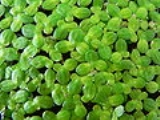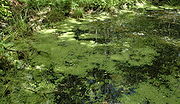
Lemna minor
Encyclopedia
Lemna minor is a species of Lemna
(duckweed) with a subcosmopolitan
distribution, native throughout most of Africa
, Asia
, Europe
and North America
, occurring everywhere that freshwater
pond
s and slow-moving stream
s occur, except for arctic and subarctic climates. It is not reported as native in Australasia
or South America
, though is naturalised
there.
It is a floating freshwater aquatic plant
, with one, two or three leaves
each with a single root
hanging in the water; as more leaves grow, the plants divide and become separate individuals. The root is 1-2 cm long. The leaves are oval, 1-8 mm long and 0.6-5 mm broad, light green, with three (rarely five) veins, and small air spaces to assist flotation. It propagates mainly by division, and flower
s are rarely produced; when produced, they are about 1 mm diameter, with a cup-shaped membranous scale containing a single ovule and two stamens. The seed
is 1 mm long, ribbed with 8-15 ribs.
 It grows in water with high nutrient levels and a pH
It grows in water with high nutrient levels and a pH
of between 5 and 9, optimally between 6.5 and 7.5, and temperatures between 6 and 33 °C. Growth of colonies is rapid, and the plant frequently forms a complete carpet across still pools when conditions are suitable. In temperate regions, when temperatures drop below 6 to 7 °C it develops small, dense, starch-filled organs called 'turions', which become dormant and sink to the water bottom for winter; the following spring, these recommence growth and float back to the surface.
It is an important food resource for many fish
and bird
s (notably duck
s); it is rich in protein
and fat
s. Birds are also important in dispersing the species to new sites; the root is sticky, enabling the plant to adhere to the plumage or feet while the bird flies from one pond to another.
as well as in outdoor ponds, though it must be frequently cut back because of its rapid growth rate and may be considered a pest. It is also grown as a commercial crop for animal feed, primarily for fish and poultry
, as it is fast-growing and easy to harvest by surface skimming.
It overcomes inter-species competition by growing a thick carpet over still water bodies, thereby shading out other plant species below it and eliminating the competition.
With intra specific competition, it will compete by absorbing as much of its surrounding resources as possible so that it has the energy to grow and reproduce.
Lemna
Lemna is a genus of free-floating aquatic plants from the duckweed family. These rapidly-growing plants have found uses as a model system for studies in community ecology, basic plant biology, in ecotoxicology, in production of biopharmaceuticals, and as a source of animal feeds for agriculture...
(duckweed) with a subcosmopolitan
Cosmopolitan distribution
In biogeography, a taxon is said to have a cosmopolitan distribution if its range extends across all or most of the world in appropriate habitats. For instance, the killer whale has a cosmopolitan distribution, extending over most of the world's oceans. Other examples include humans, the lichen...
distribution, native throughout most of Africa
Africa
Africa is the world's second largest and second most populous continent, after Asia. At about 30.2 million km² including adjacent islands, it covers 6% of the Earth's total surface area and 20.4% of the total land area...
, Asia
Asia
Asia is the world's largest and most populous continent, located primarily in the eastern and northern hemispheres. It covers 8.7% of the Earth's total surface area and with approximately 3.879 billion people, it hosts 60% of the world's current human population...
, Europe
Europe
Europe is, by convention, one of the world's seven continents. Comprising the westernmost peninsula of Eurasia, Europe is generally 'divided' from Asia to its east by the watershed divides of the Ural and Caucasus Mountains, the Ural River, the Caspian and Black Seas, and the waterways connecting...
and North America
North America
North America is a continent wholly within the Northern Hemisphere and almost wholly within the Western Hemisphere. It is also considered a northern subcontinent of the Americas...
, occurring everywhere that freshwater
Freshwater
Fresh water is naturally occurring water on the Earth's surface in ice sheets, ice caps, glaciers, bogs, ponds, lakes, rivers and streams, and underground as groundwater in aquifers and underground streams. Fresh water is generally characterized by having low concentrations of dissolved salts and...
pond
Pond
A pond is a body of standing water, either natural or man-made, that is usually smaller than a lake. A wide variety of man-made bodies of water are classified as ponds, including water gardens, water features and koi ponds; all designed for aesthetic ornamentation as landscape or architectural...
s and slow-moving stream
Stream
A stream is a body of water with a current, confined within a bed and stream banks. Depending on its locale or certain characteristics, a stream may be referred to as a branch, brook, beck, burn, creek, "crick", gill , kill, lick, rill, river, syke, bayou, rivulet, streamage, wash, run or...
s occur, except for arctic and subarctic climates. It is not reported as native in Australasia
Australasia
Australasia is a region of Oceania comprising Australia, New Zealand, the island of New Guinea, and neighbouring islands in the Pacific Ocean. The term was coined by Charles de Brosses in Histoire des navigations aux terres australes...
or South America
South America
South America is a continent situated in the Western Hemisphere, mostly in the Southern Hemisphere, with a relatively small portion in the Northern Hemisphere. The continent is also considered a subcontinent of the Americas. It is bordered on the west by the Pacific Ocean and on the north and east...
, though is naturalised
Naturalisation (biology)
In biology, naturalisation is any process by which a non-native organism spreads into the wild and its reproduction is sufficient to maintain its population. Such populations are said to be naturalised....
there.
It is a floating freshwater aquatic plant
Aquatic plant
Aquatic plants are plants that have adapted to living in aquatic environments. They are also referred to as hydrophytes or aquatic macrophytes. These plants require special adaptations for living submerged in water, or at the water's surface. Aquatic plants can only grow in water or in soil that is...
, with one, two or three leaves
Leaf
A leaf is an organ of a vascular plant, as defined in botanical terms, and in particular in plant morphology. Foliage is a mass noun that refers to leaves as a feature of plants....
each with a single root
Root
In vascular plants, the root is the organ of a plant that typically lies below the surface of the soil. This is not always the case, however, since a root can also be aerial or aerating . Furthermore, a stem normally occurring below ground is not exceptional either...
hanging in the water; as more leaves grow, the plants divide and become separate individuals. The root is 1-2 cm long. The leaves are oval, 1-8 mm long and 0.6-5 mm broad, light green, with three (rarely five) veins, and small air spaces to assist flotation. It propagates mainly by division, and flower
Flower
A flower, sometimes known as a bloom or blossom, is the reproductive structure found in flowering plants . The biological function of a flower is to effect reproduction, usually by providing a mechanism for the union of sperm with eggs...
s are rarely produced; when produced, they are about 1 mm diameter, with a cup-shaped membranous scale containing a single ovule and two stamens. The seed
Seed
A seed is a small embryonic plant enclosed in a covering called the seed coat, usually with some stored food. It is the product of the ripened ovule of gymnosperm and angiosperm plants which occurs after fertilization and some growth within the mother plant...
is 1 mm long, ribbed with 8-15 ribs.

PH
In chemistry, pH is a measure of the acidity or basicity of an aqueous solution. Pure water is said to be neutral, with a pH close to 7.0 at . Solutions with a pH less than 7 are said to be acidic and solutions with a pH greater than 7 are basic or alkaline...
of between 5 and 9, optimally between 6.5 and 7.5, and temperatures between 6 and 33 °C. Growth of colonies is rapid, and the plant frequently forms a complete carpet across still pools when conditions are suitable. In temperate regions, when temperatures drop below 6 to 7 °C it develops small, dense, starch-filled organs called 'turions', which become dormant and sink to the water bottom for winter; the following spring, these recommence growth and float back to the surface.
It is an important food resource for many fish
Fish
Fish are a paraphyletic group of organisms that consist of all gill-bearing aquatic vertebrate animals that lack limbs with digits. Included in this definition are the living hagfish, lampreys, and cartilaginous and bony fish, as well as various extinct related groups...
and bird
Bird
Birds are feathered, winged, bipedal, endothermic , egg-laying, vertebrate animals. Around 10,000 living species and 188 families makes them the most speciose class of tetrapod vertebrates. They inhabit ecosystems across the globe, from the Arctic to the Antarctic. Extant birds range in size from...
s (notably duck
Duck
Duck is the common name for a large number of species in the Anatidae family of birds, which also includes swans and geese. The ducks are divided among several subfamilies in the Anatidae family; they do not represent a monophyletic group but a form taxon, since swans and geese are not considered...
s); it is rich in protein
Protein
Proteins are biochemical compounds consisting of one or more polypeptides typically folded into a globular or fibrous form, facilitating a biological function. A polypeptide is a single linear polymer chain of amino acids bonded together by peptide bonds between the carboxyl and amino groups of...
and fat
Fat
Fats consist of a wide group of compounds that are generally soluble in organic solvents and generally insoluble in water. Chemically, fats are triglycerides, triesters of glycerol and any of several fatty acids. Fats may be either solid or liquid at room temperature, depending on their structure...
s. Birds are also important in dispersing the species to new sites; the root is sticky, enabling the plant to adhere to the plumage or feet while the bird flies from one pond to another.
Cultivation and uses
It is often used as a plant in both coldwater and tropical aquariaAquarium
An aquarium is a vivarium consisting of at least one transparent side in which water-dwelling plants or animals are kept. Fishkeepers use aquaria to keep fish, invertebrates, amphibians, marine mammals, turtles, and aquatic plants...
as well as in outdoor ponds, though it must be frequently cut back because of its rapid growth rate and may be considered a pest. It is also grown as a commercial crop for animal feed, primarily for fish and poultry
Poultry
Poultry are domesticated birds kept by humans for the purpose of producing eggs, meat, and/or feathers. These most typically are members of the superorder Galloanserae , especially the order Galliformes and the family Anatidae , commonly known as "waterfowl"...
, as it is fast-growing and easy to harvest by surface skimming.
Population and Competition
Lemna minor is structurally adapted to grow quickly. That enables it to populate bodies of water rapidly.It overcomes inter-species competition by growing a thick carpet over still water bodies, thereby shading out other plant species below it and eliminating the competition.
With intra specific competition, it will compete by absorbing as much of its surrounding resources as possible so that it has the energy to grow and reproduce.

